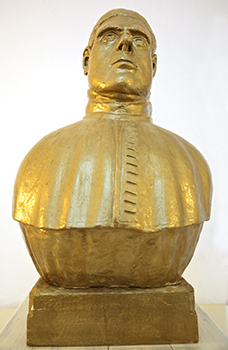 |
Important benefactor of the locality, Rector of the Parish Church, of full name Luís José António da Cruz, was the youngest son of José António da Cruz and D. Maria Francisca. Paternal grandchild of João da Cruz Loureiro and Joana Maria, and maternal grandson of André Lopes Ruivo and Margarida Martins, all of them from Viana. He was baptized in the same locality, on 30th April 1777, his godfather being the outside judge Luís José Aleixo Pais. He passed away in this village on 26th September 1848, at the age of 71.
Having studied in Évora, in particular the Theology classes of the Colégio do Espírito Santo, with the intention of reaching priestly state, in 1797 his parents gave him dowry so that he could become Subdeacon. Initially, the donated patrimony consisted of a cultivated land with olive trees in the place of Bismo, protected areas of Viana where hunting was forbidden, which he came to possess on 12th July of that year. However, legal issues hindered the possibility of receiving that asset, which determined a new donation of his parents, on 27th October. This time he was given a cultivated land and an olive grove in Malfor and a cultivated land and an olive grove in Poço Concelho.
The fact that we know that his father was a clerk in Viana’s council and Familiar of the Holy Office (Inquisition) allows us to assume that he was born in a family with local social prominence and some economic freedom. This favourable financial condition is attested in his process of qualification to take orders, where some of his sisters claimed that their father had many other goods beyond those with which Luís António was endowed.
In fact, the entire household was composed of his father, his mother and, that is referenced, five older brothers: a boy named Francisco António da Cruz, who was also a priest but in 1791 had already passed away; and four girls whose names, from the oldest to the youngest, were Joana Maria da Esperança, Josefa Joaquina, Maria Francisca Antónia and Teresa Luísa de Santa Ana. In 1798 they were all single and were between 25 and 34 years old. Luís António was then 21 years old. Despite the family’s apparent economic comfort, we assume that sustaining so many girls was not a simple task. It should be noted that they lived in a time when women from more prominent social groups didn’t work and, by the time’s patterns, they had already an advanced age to marry.
Throughout his life he inherited from his parents several goods to which he still added others, acquired by purchase. Concerning him, João Manuel Santana de Sousa says: "The mortmain goods sold by the state in public auction, as national goods, reached low prices. To the auctions attended, sometimes, only a single interested person, who acquired the lands by the base bid. Few had capital to invest. (...) The case of Father Luís António da Cruz is enlightening. Up to 1811 he had accumulated 22 farms (lands for pasture, small cultivated lands, vineyards and olive groves) and owned 3 estates.” By the time of his death, on 26th September 1848, he left the estates of Monte das Pedras, Marmelos, Famais, Montinho do Palanque, Cega Gatos, Flor da Rosa, Espadaneira, Fevereira and Vinagra, two shares of income on the Estate da Cegonha and on the Estate do Aniel, the Gafanhão farm and also the gardens of Santo António and Cancela. Also joining these were 24 properties of small or medium size (lands for pasture, small cultivated lands, vineyards and olive groves). This means that in 37 years, between 1811 and 1848, he passed from owner of three estates to owner of nine, to which he also added two shares of income from two other estates, one farm, two gardens and two more small or medium sized properties. He also owned the house where he lived in the former street of Carreteiros, now street Pe. Luís António da Cruz, a toponymy change operated after the Republic was established in 1910. The profits of the ownership of all these properties allowed him to accumulate a fortune that he used, together with goods of another nature, for beneficence ends. In his will, dated from 16th September 1848, he dedicated his grand patrimony to the maintenance of a chapel for daily mass, an asylum, a school and a Mount of piety. He promoted, thus, the constitution of what was called, after the death of the testator, Institute of Piety and Beneficence
REFERENCES
FARRICA, Fátima, Farrica, Fátima, "Uma descrição da capela do Santíssimo Sacramento de Viana do Alentejo", Callipole: Revista de Cultura, nº 19, 2011, pp. 267-275.
FARRICA, Fátima, No Espaço e no Tempo: Contributos para a História das Instituições de Viana do Alentejo (Séculos XIV-XIX), Casal de Cambra, Caleidoscópio, 2015.

 Abrir Lista
Abrir Lista MUNICÍPIO DE VIANA DO ALENTEJO
MUNICÍPIO DE VIANA DO ALENTEJO